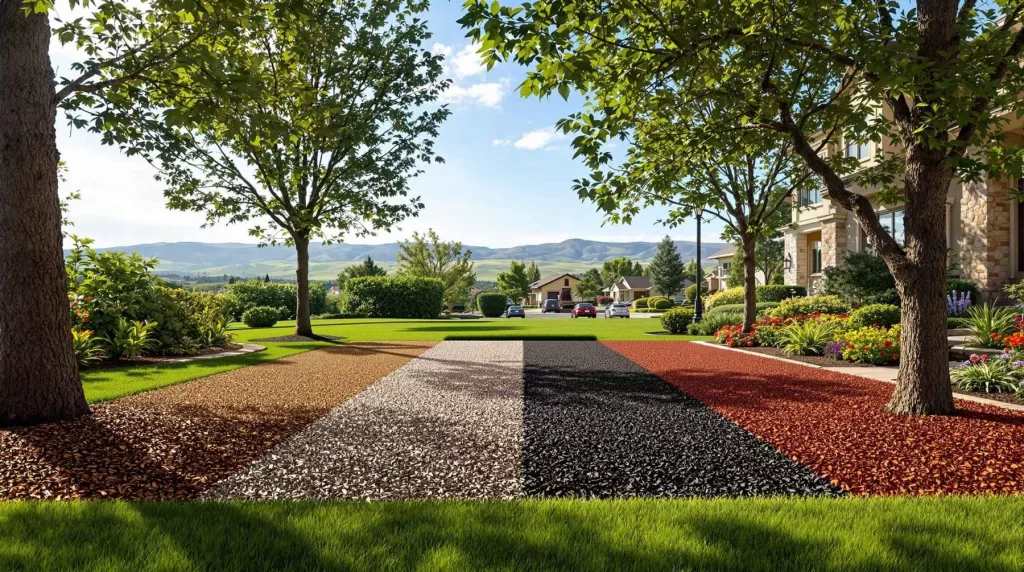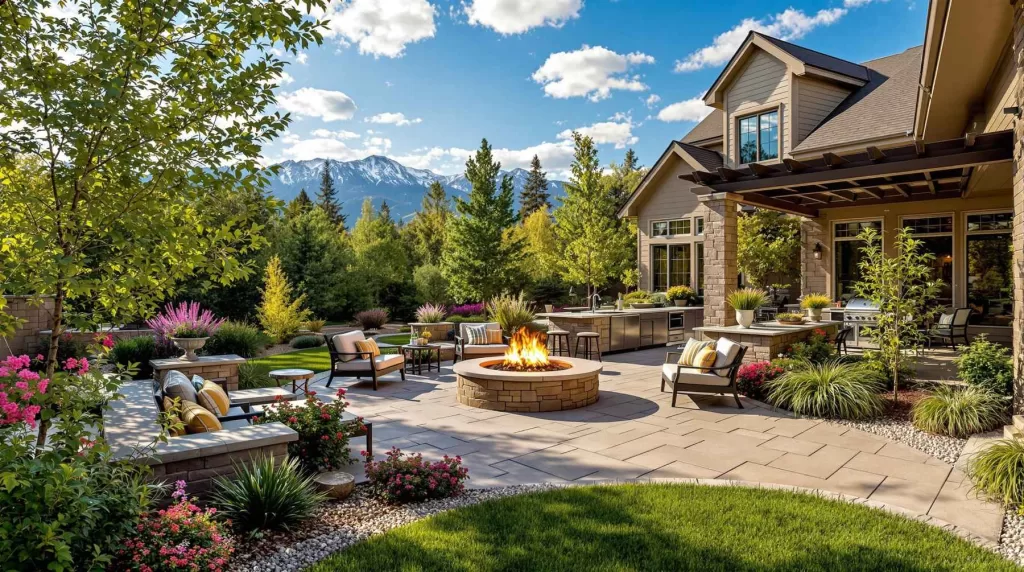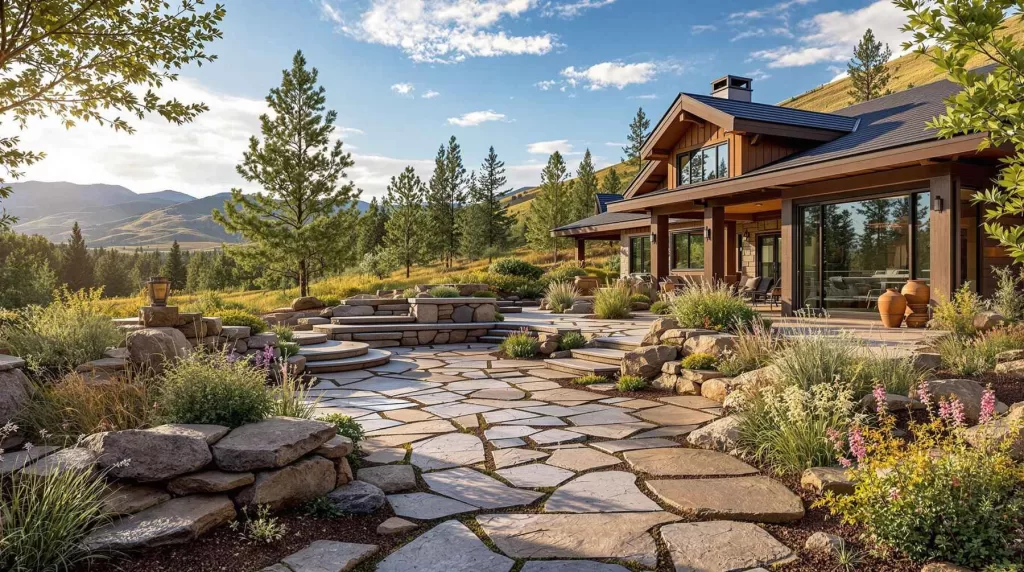Introduction
Choosing the right mulch is more than just a visual decision — it’s a key part of protecting your plants, conserving water, and keeping your yard low-maintenance year-round. In Castle Pines, Colorado, elevation, soil composition, and HOA regulations all play a role in determining the ideal mulch type. This guide breaks down the best options for local homeowners, helping you create a landscape that thrives in our unique environment.
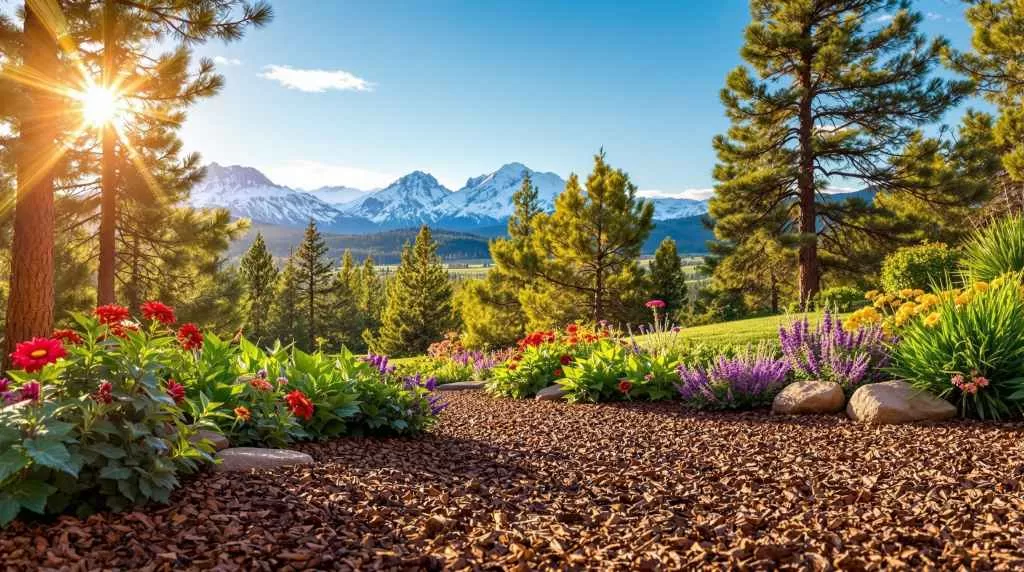
Understanding the Role of Mulch in Castle Pines
Mulch plays a major role in the success of Castle Pines landscaping by helping retain moisture, regulate soil temperatures, and improve plant health year-round — all while reducing water usage and suppressing weeds.
Why Mulch Matters in High-Elevation Areas
Castle Pines sits over 6,000 feet above sea level, which means thinner air, intense sun, and fluctuating temperatures. Mulch helps protect plant roots by insulating the soil, locking in moisture, and reducing UV exposure that can dry out unprotected ground quickly.
Mulch and Soil Health in Castle Pines
Over time, mulch plays a major role in enhancing soil structure by encouraging beneficial microbial activity and reducing compaction. Organic mulch types like bark and compost slowly break down and feed the soil, improving its fertility with every season.
Water Conservation Benefits in Douglas County
In a region where water conservation is increasingly important, mulch acts as a natural barrier against evaporation. A proper mulch layer can reduce water loss by up to 70%, keeping plants hydrated longer and reducing how often you need to run your irrigation system.
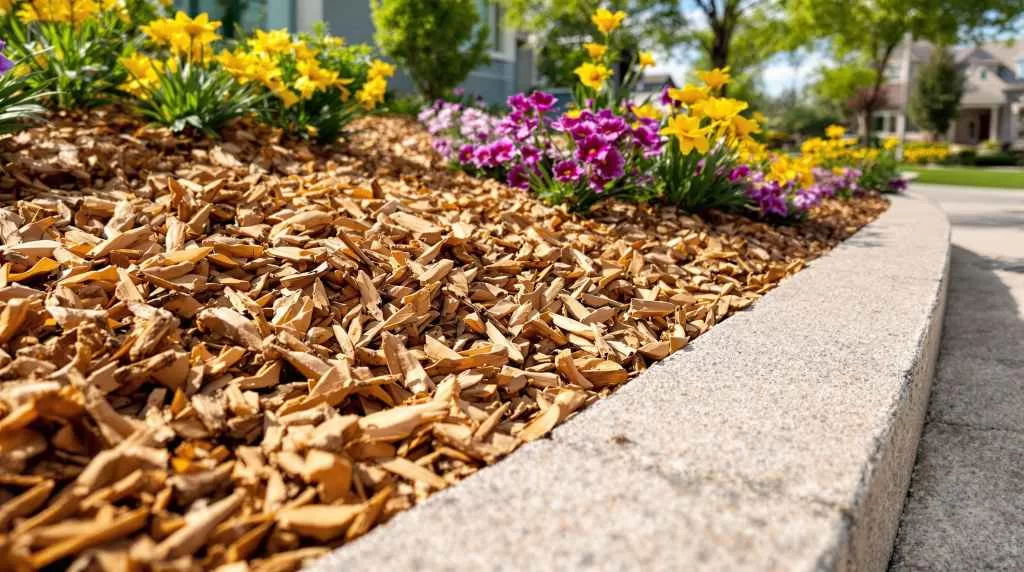
Organic Mulch Options for Castle Pines
Many Castle Pines backyard landscaping experts recommend organic mulch because it not only enhances curb appeal but also contributes to long-term soil health, moisture retention, and weed control as it breaks down naturally over time.
Shredded Cedar Mulch
Shredded cedar mulch is a top choice in Castle Pines for its natural insect-repelling oils and ability to stay in place during heavy winds. Its warm color and aromatic scent make it a popular option for flower beds, walkways, and decorative borders.
Bark Mulch (Pine and Fir)
Bark mulch made from pine or fir offers a clean, layered look that slowly decomposes and improves soil fertility. It’s well-suited for areas around trees and shrubs but may slightly acidify the soil, which works well for acid-loving plants like evergreens.
Wood Chips and Playground Mulch
Wood chips are chunkier than bark mulch and hold up well in high-traffic or utility areas, making them ideal around playsets or along footpaths. While they decompose more slowly, they still contribute some organic value to the soil over time.
Compost Mulch and Soil Amendment
Composted mulch is a blend of decomposed organic matter that enriches the soil with valuable nutrients and microbial life. It’s best used in garden beds where both moisture retention and ongoing soil improvement are priorities.
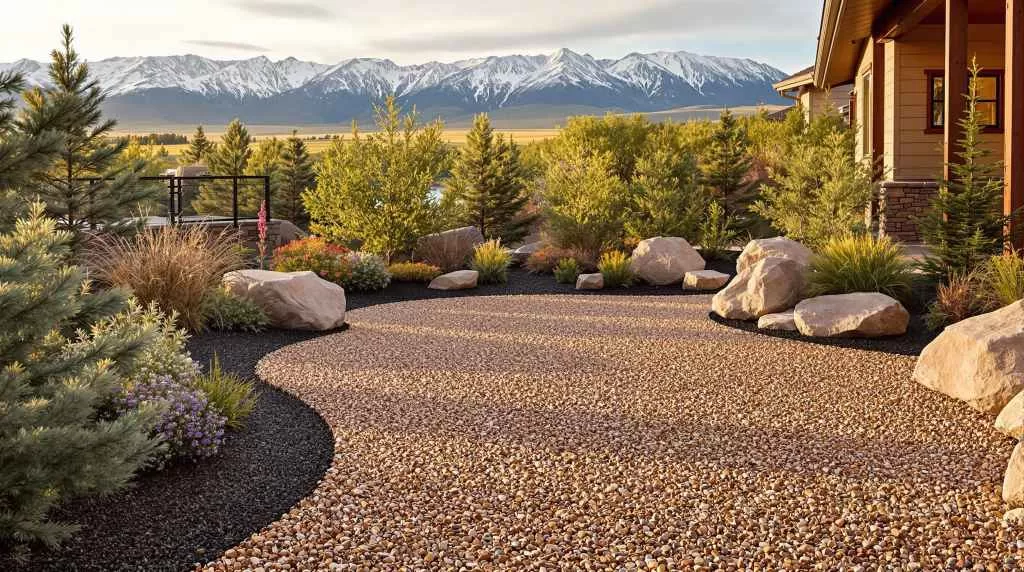
Inorganic Mulch Options for Castle Pines
While organic mulches improve soil over time, inorganic mulch options offer low-maintenance durability that many Castle Pines homeowners prefer—especially in xeriscape designs or modern landscape styles. These materials don’t decompose, making them ideal for long-term coverage in areas where plant growth is minimal or water conservation is a top priority.
Rock and Gravel Mulch
Rock mulch, including pea gravel, crushed granite, and river rock, provides a clean, upscale look with virtually no maintenance required. It’s excellent for sloped areas, around hardscapes, or in full-sun xeriscapes, but keep in mind that rock can absorb and radiate heat, which may stress nearby plants during summer.
Rubber Mulch for Low-Maintenance Areas
Rubber mulch is made from recycled tires and is popular in play areas and utility spaces because it doesn’t decompose or shift easily. It cushions foot traffic, suppresses weeds effectively, and comes in various colors, but it offers no benefit to soil health and may have a synthetic smell when first installed.
Landscape Fabric with Decorative Covering
Using landscape fabric beneath gravel or bark mulch adds an extra layer of weed suppression and moisture control. While this approach reduces weed growth long-term, it must be installed correctly to allow water and air to reach the soil—otherwise, it can suffocate plant roots or cause drainage issues over time.
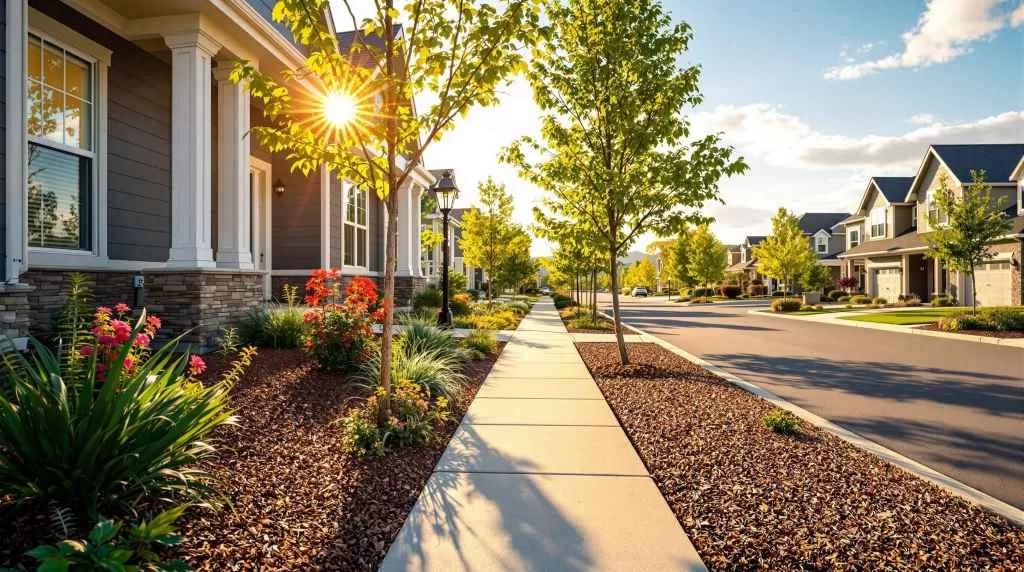
Matching Mulch to Castle Pines HOA Guidelines
Navigating HOA expectations can be tricky, but many local landscapers are familiar with Castle Pines regulations and can recommend mulch types that meet both design goals and neighborhood standards. Choosing the right material from the start can help avoid compliance issues and costly rework.
Common HOA Regulations to Watch For
Most Castle Pines HOAs enforce guidelines related to mulch color, material, and placement. Black or dark brown mulch is often preferred over red or brightly dyed options, and natural-looking materials like bark or stone are typically required in front yards.
Mulch Aesthetics and Curb Appeal
Mulch plays a major role in how tidy and intentional your landscape appears. Using color-coordinated mulch that complements your home’s exterior and hardscape elements can significantly boost curb appeal while staying within HOA-approved standards.
Noise and Odor Considerations
Some HOAs have received complaints about certain mulch types that produce unpleasant smells or sound. Rubber mulch, for instance, can carry a strong odor during hot weather, and gravel may shift loudly when walked on—both of which may be discouraged in more tightly governed neighborhoods.
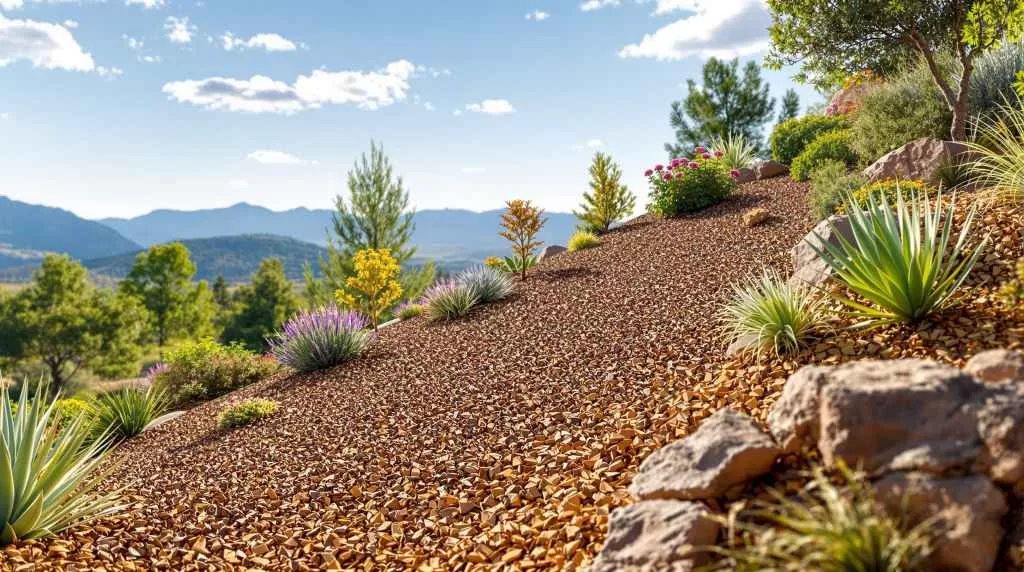
Climate Considerations for Mulch in Castle Pines
When selecting mulch, it’s important to factor in the region’s intense sun, dry air, and fluctuating temperatures. Many homeowners looking for Castle Pines yard design services are surprised at how much climate affects mulch performance—from how well it stays in place to how quickly it breaks down.
Freeze-Thaw Cycles and Mulch Stability
Castle Pines experiences frequent freeze-thaw cycles, especially in spring and fall. These conditions can cause mulch to shift or compress, which is why heavier options like bark nuggets or rock are often more stable than lightweight alternatives like straw or fine shredded wood.
Wind Exposure and Mulch Displacement
Because many homes in Castle Pines are built on open lots or near ridgelines, wind can displace lighter mulch easily. Shredded wood and compost may require edging or additional stabilization, while stone and large bark pieces are less likely to blow away.
Sun Exposure and Color Fading
The strong Colorado sun can quickly bleach mulch color, especially with dyed or low-quality materials. To keep your landscape looking fresh, opt for UV-resistant mulch types or plan to refresh the top layer annually in highly exposed areas.
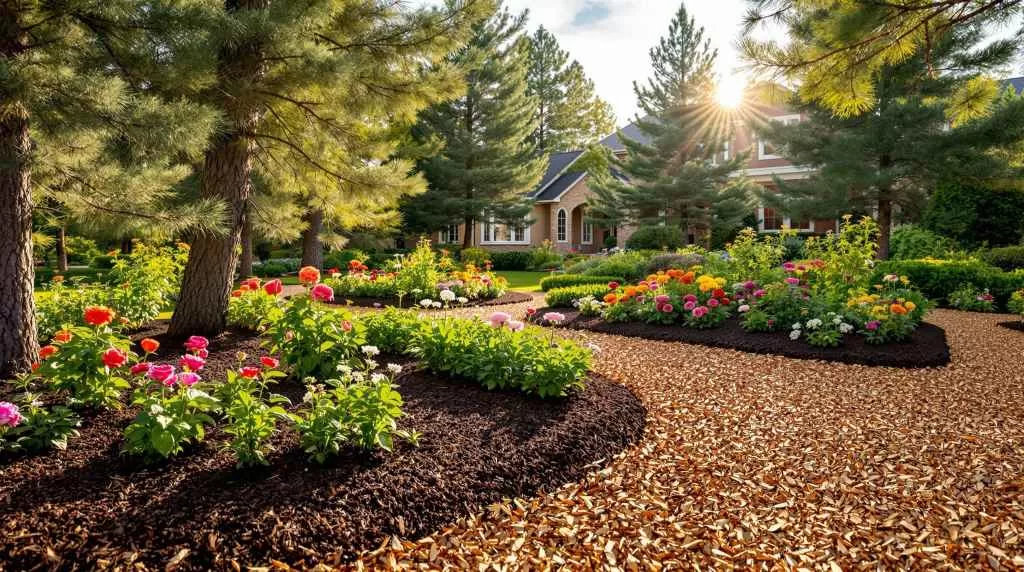
Mulch for Plant-Specific Needs
Different plants have different needs, which is why working with an experienced Landscape Designer can make a big difference when selecting mulch types. Whether you’re planting trees, flowers, or vegetables, the right mulch supports plant health while reducing maintenance requirements.
Mulch for Trees and Shrubs
Trees and shrubs benefit most from coarse organic mulch like bark or wood chips, which insulate the root zone and retain moisture without compacting. A wide mulch ring also protects trunks from lawnmower damage and improves long-term soil structure.
Mulch for Perennials and Annuals
Flower beds with perennials and annuals thrive under fine-textured mulch like shredded bark or compost. These materials break down faster, adding nutrients to the soil while allowing new plantings to push through more easily each season.
Mulch for Vegetable Gardens
In edible gardens, mulch must support both soil health and crop production. Compost and straw are top choices, offering temperature control, moisture retention, and improved fertility. Avoid dyed or treated mulch near vegetables to ensure food safety.
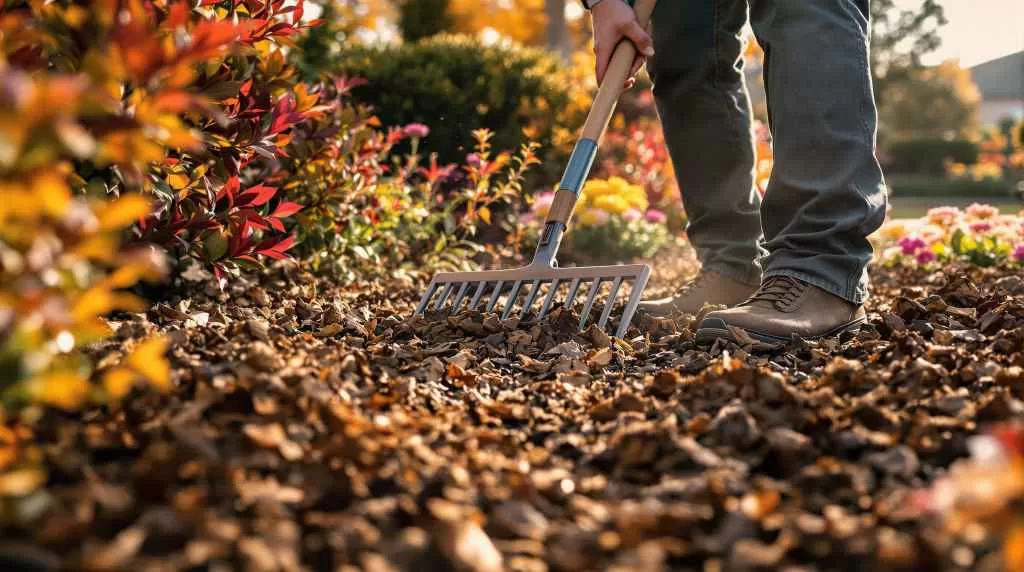
Maintenance and Replacement Considerations
Mulch isn’t a one-time solution—it requires occasional upkeep to maintain its benefits and visual appeal. Homeowners who prioritize Landscape Maintenance should consider how often their chosen mulch type needs to be replenished, replaced, or refreshed to keep the landscape looking polished year-round.
How Often to Replace Mulch in Castle Pines
Organic mulches like bark and compost generally need to be replenished every 1–2 years, while inorganic options like gravel can last much longer with minimal maintenance. The timeline depends on local weather, sun exposure, and how fast the material breaks down.
Signs It’s Time to Replenish or Replace
Look for mulch that has visibly faded, thinned out, or compacted, especially after harsh seasons. If weeds start popping through or moisture retention seems reduced, it’s likely time to top off your mulch layer or replace it entirely.
Tips for Extending the Life of Your Mulch
You can extend mulch longevity by installing it at the correct depth (2–4 inches), avoiding excessive foot traffic, and using edging to keep it contained. Raking the surface occasionally helps aerate the layer and prevents matting or mildew buildup.
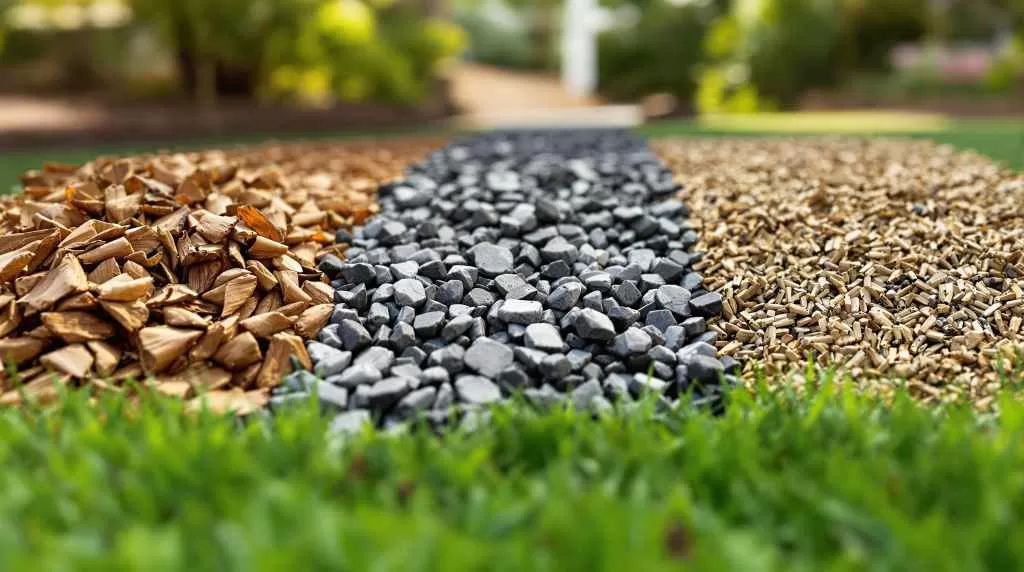
Cost Comparisons and Long-Term Value
Not all mulch options are created equal when it comes to cost. While some materials are cheaper upfront, others offer greater longevity and lower replacement frequency, saving money over time. This section helps break down what to expect in terms of budget and value.
Upfront Costs by Mulch Type
Organic mulches like shredded bark and wood chips are typically the most affordable, ranging from $200 to $250 per cubic yard installed. In contrast, rubber mulch and decorative rock can cost significantly more, especially when factoring in delivery and labor.
Long-Term Cost Efficiency
Though gravel and rubber mulch have higher initial costs, they often last 5–10 years or more, making them cost-effective for long-term installations. Organic mulch may be cheaper upfront, but it will need to be replenished more frequently, adding to long-term expenses.
Professional Installation vs. DIY
DIY mulch installation can save money, but hiring a professional ensures proper depth, even coverage, and correct integration with other landscape elements. For large yards or HOAs with strict standards, expert installation can be well worth the investment.
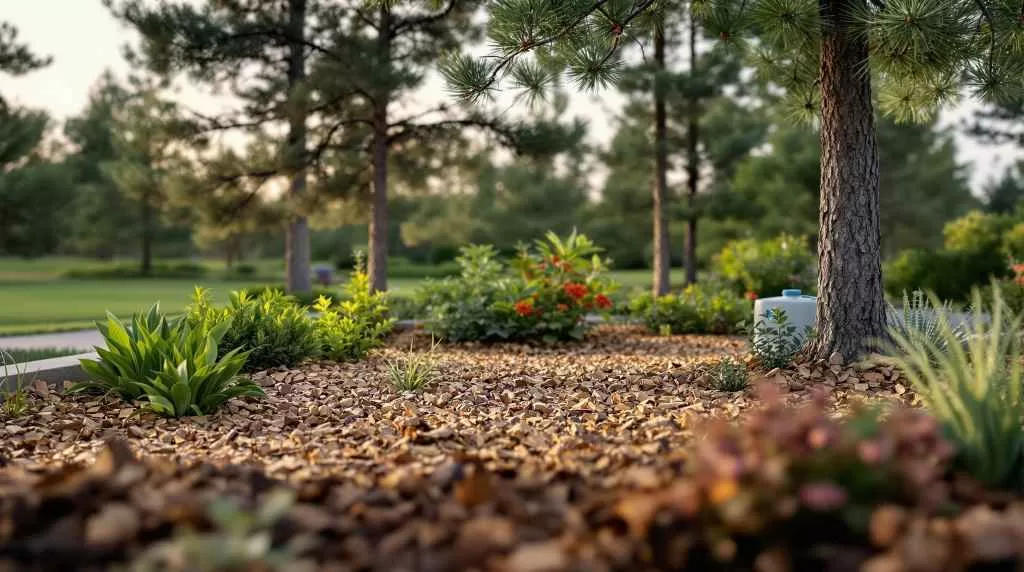
Environmentally Friendly Mulch Choices
Sustainable landscaping is more important than ever in Castle Pines, and mulch selection plays a key role. Choosing eco-conscious materials not only supports healthy soil and plant life but also helps reduce landfill waste and water consumption.
Sustainable Sourcing and Local Materials
Opt for mulch that is locally sourced or repurposed, such as untreated wood chips from tree trimmings or municipal compost. These materials reduce transportation emissions and support regional sustainability initiatives.
Mulch That Supports Biodiversity
Organic mulches like bark, compost, and leaf mold create a microhabitat for beneficial insects and microbes, improving the overall health of your landscape. They also promote natural pest control by attracting pollinators and predatory insects.
Avoiding Mulch That Harms the Environment
Steer clear of mulches dyed with unnatural chemicals or petroleum-based colors, especially red-dyed options that may leach toxins. Also avoid synthetic mulches in vegetable gardens or areas where soil health and groundwater protection are priorities.
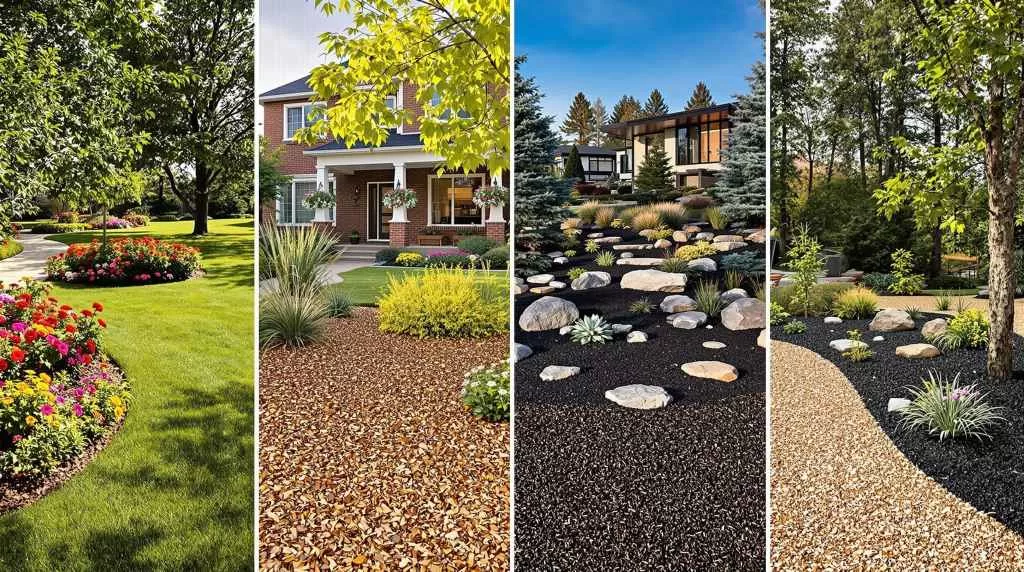
Best Mulch Types for Popular Castle Pines Landscaping Styles
Different landscape styles call for different mulch materials, and the right match can enhance both function and design. A trusted Landscaping Company in Castle Pines can help you choose a mulch that suits your property’s aesthetic, maintenance goals, and HOA expectations while keeping your yard looking cohesive and polished.
Traditional Front Yards
For classic curb appeal, dark brown bark mulch or shredded cedar works well around foundation plantings and flower beds. These options offer a timeless look and blend seamlessly with most home exteriors and garden designs.
Native and Xeriscape Gardens
In drought-tolerant or native landscapes, decorative gravel or crushed stone is a top choice. These inorganic mulches emphasize clean lines and low maintenance while complementing hardy native plants that thrive in Castle Pines’ dry climate.
Modern and Contemporary Landscapes
Sleek, minimalist yards benefit from rubber mulch or black lava rock, which create striking contrast and modern texture. These materials pair well with metal edging, structured planting beds, and geometric hardscaping elements.
Wooded or Naturalized Lots
For homes surrounded by trees or backing to open space, natural wood chips or bark nuggets maintain a rustic, organic appearance. These mulches help native vegetation blend into the landscape and support healthy forest-like soil conditions.
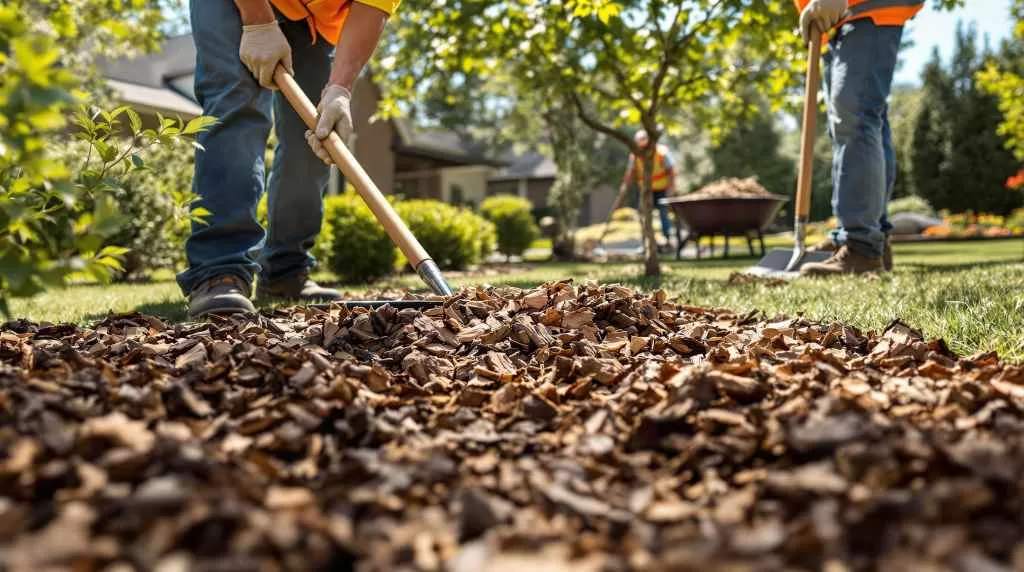
Mulch Installation Tips from Local Experts
Even the best mulch won’t perform well if it’s installed incorrectly. These tips from Castle Pines landscape professionals can help ensure your mulch is both beautiful and functional, supporting plant health while keeping your yard tidy and efficient.
How Deep Should Mulch Be?
The ideal mulch depth is 2 to 4 inches, depending on the material and the location. Too little mulch won’t suppress weeds effectively, while too much can suffocate plant roots or retain excess moisture, leading to rot.
Should You Use a Weed Barrier Under Mulch?
Weed barriers like landscape fabric are best used beneath inorganic mulches like rock or rubber, but they’re often discouraged under organic mulch. That’s because they can block water and nutrients from reaching the soil and hinder natural decomposition that improves soil health.
Preventing Mulch Volcanoes Around Trees
Avoid piling mulch against tree trunks—a common mistake known as a “mulch volcano.” Instead, create a shallow, donut-shaped ring around the base, keeping mulch a few inches away from the trunk to prevent rot and pest problems.
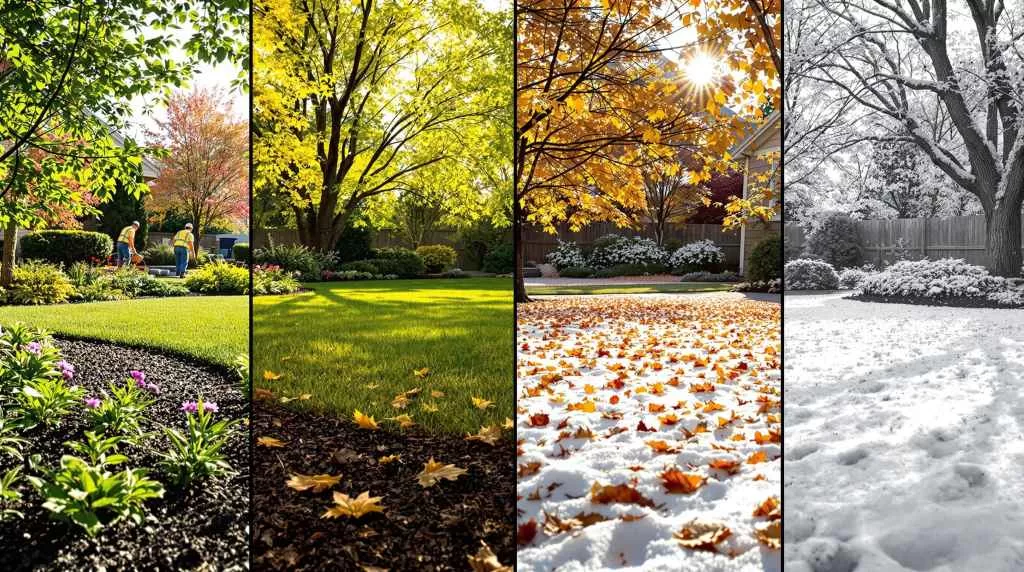
Seasonal Mulch Advice for Castle Pines Residents
Each season presents unique challenges for mulch performance in Colorado’s climate. A knowledgeable Castle Pines landscaper can help you time your mulch applications to maximize water retention, root protection, and visual appeal throughout the year.
Spring Mulching Tips
Spring is a great time to refresh your mulch beds, especially after winter snow has compacted or discolored existing layers. Apply a fresh 1–2 inch topcoat to restore color and enhance insulation as plants begin their growing season.
Summer Mulching Strategies
During hot, dry months, mulch becomes a frontline defense against soil evaporation and root stress. Make sure mulch remains at an even depth and hasn’t blown away or thinned out in exposed areas.
Fall Mulching for Insulation
Adding mulch in the fall helps insulate plant roots before winter. This is especially important for perennials and shrubs, which benefit from the extra protection against sudden temperature drops and frost heave.
Winter Mulch Considerations
While mulch isn’t typically added during winter, it’s important to check for compaction or displacement caused by snow, ice, or wind. Avoid walking on frozen mulch layers to prevent damaging the underlying soil and plant roots.
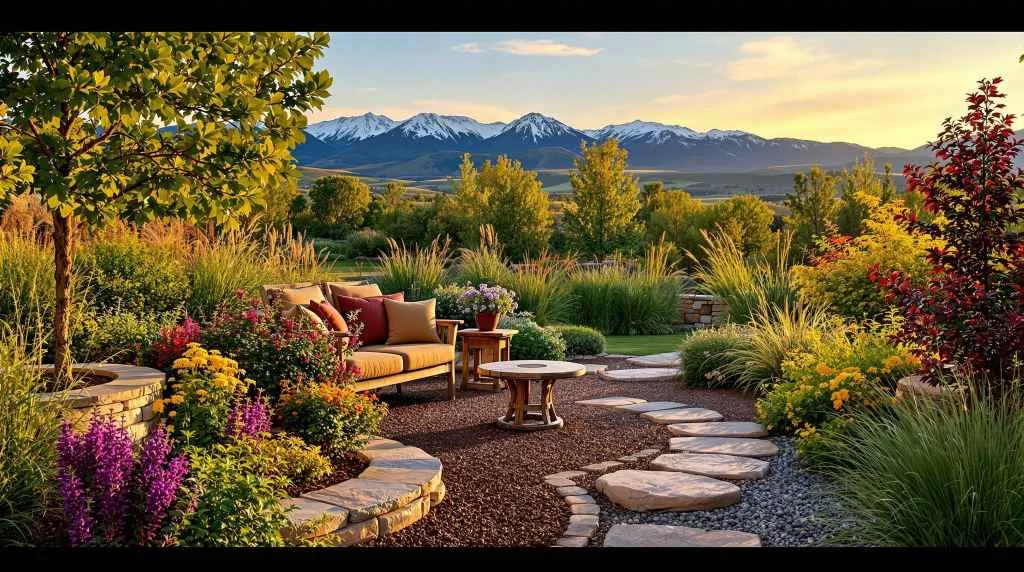
Ready to Transform Your Outdoor Space?
Whether you’re updating mulch beds, reimagining your front yard, or planning a full landscape makeover, our team is here to help. At Custom Landscapes by Design, we specialize in creating functional, beautiful, and HOA-compliant outdoor spaces in Castle Pines and nearby areas like Castle Rock, Parker, and Lone Tree. If you’re unsure which mulch is right for your yard, we’ll walk you through the options and tailor everything to your soil, style, and climate. Reach out today and let us show you how the right mulch can elevate your entire landscape.

